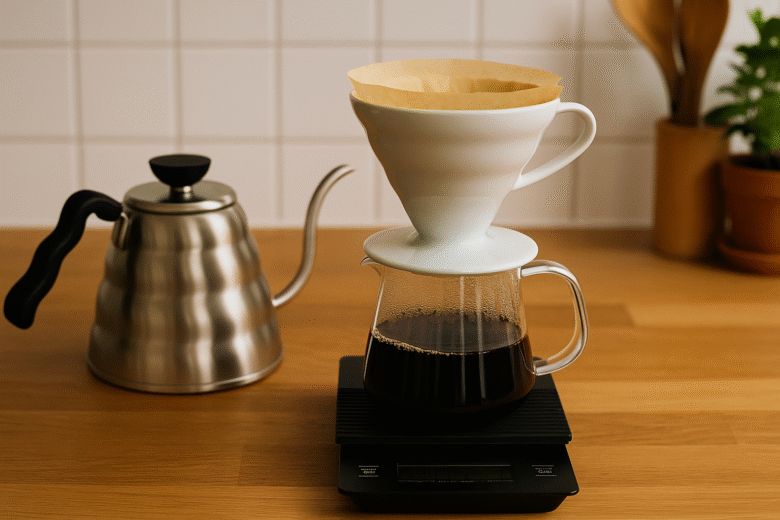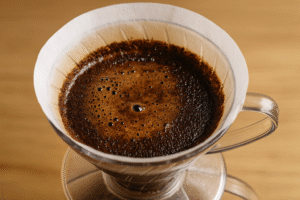Pour-over coffee is a favorite among coffee lovers for its clarity, aroma, and the control it gives you over the brewing process. Unlike automatic machines, this manual method allows you to fine-tune every detail—from grind size to pouring technique.
While it may seem intimidating at first, pour-over coffee is actually simple once you understand the steps. With the right tools and a little patience, you can brew a clean and flavorful cup every morning.
Let’s break down exactly how to make pour-over coffee at home like a pro.
What Is Pour-Over Coffee?
Pour-over coffee is made by manually pouring hot water over coffee grounds in a filter, allowing the water to extract flavor as it passes through the coffee into a carafe or mug below.
This method emphasizes clarity and subtle flavors in the coffee, making it ideal for single-origin beans or light roasts that showcase delicate tasting notes.
Popular pour-over tools include the Hario V60, Chemex, and Kalita Wave. Each has its own slight variations, but the core brewing principles are the same.
Why Choose Pour-Over?
- Full control over brewing variables
- Bright, clear, and complex flavor profile
- Great for highlighting specialty beans
- Minimal equipment required
- A calming, ritualistic experience
Essential Equipment for Pour-Over Coffee
- A pour-over dripper (Hario V60, Kalita Wave, or Chemex)
- Filter papers (specific to your dripper)
- Fresh coffee beans
- A burr grinder (for a medium grind)
- A gooseneck kettle (for precision pouring)
- Digital scale
- Timer
- Hot water (90–96°C or 195–205°F)
- Mug or carafe
Step-by-Step Guide to Brewing Pour-Over Coffee
1. Heat Your Water
Bring your water to a boil, then let it cool for 30 seconds. You want it between 90–96°C.
Start with around 300ml of water for a single 20g dose of coffee. Boiling water can scald the grounds, while water that’s too cool will under-extract the flavors.
2. Grind Your Coffee
Grind 20g of fresh coffee beans to a medium-fine texture—similar to sea salt.
Use a burr grinder for consistent particle size, which helps ensure even extraction.
3. Prepare Your Filter and Dripper
Place the filter in your dripper and rinse it with hot water. This removes any paper taste and preheats the brewer.
Discard the rinse water and place the dripper over your mug or carafe.
4. Add the Coffee Grounds
Add the coffee to the filter. Level the bed by gently shaking or tapping the dripper. Place everything on the scale and zero it.
You’re now ready to brew.
5. Bloom the Coffee
Start your timer and pour just enough water to saturate all the coffee—about 40g.
Let it bloom for 30–45 seconds. This releases trapped carbon dioxide and allows even extraction.
You’ll see bubbles form as the gas escapes, especially with fresh beans.
6. Pour in a Spiral Motion
After blooming, slowly pour water in concentric circles, starting from the center and working outward.
Add water in stages until you reach 300g total. This should take 2:30 to 3:30 minutes total brew time.
Pour gently and steadily. Avoid pouring on the filter walls, which can cause channeling and uneven extraction.
7. Let It Drain and Serve
Once the water has fully drained, remove the dripper and give the coffee a gentle swirl.
Serve it hot in a pre-warmed mug to maintain temperature and aroma.
Enjoy the clean, vibrant flavors that pour-over brewing brings out.
Troubleshooting Your Pour-Over
Coffee too bitter? Try a coarser grind, cooler water, or a shorter brew time.
Coffee too sour or weak? Use finer grind, hotter water, or a longer brew.
Brew is slow or clogged? Grind may be too fine or filter paper is folded.
Water rushing through too fast? Grind may be too coarse.
Tips for Better Pour-Over Coffee
- Use a gooseneck kettle for control
- Use a timer and scale for precision
- Buy freshly roasted beans and grind right before brewing
- Experiment with ratios (start with 1:15, adjust as needed)
- Swirl or stir your coffee before sipping for even flavor
- Try different origins and roasts to explore taste variety
Popular Pour-Over Variations
- Hario V60: Conical design with one large hole. Requires good pouring technique.
- Kalita Wave: Flat-bottom with three holes. Easier for beginners, balanced flow.
- Chemex: Larger format with thick filters. Produces very clean, bright coffee.
Each offers a slightly different experience—try a few and see what suits your taste and style.
Frequently Asked Questions (FAQs)
1. Can I use pre-ground coffee?
Yes, but it’s better to grind fresh. Pre-ground often lacks the ideal grind size and loses aroma fast.
2. What’s the best water to use?
Filtered or spring water with moderate minerals is ideal. Avoid distilled water—it lacks necessary elements for flavor extraction.
3. How long does pour-over take?
The entire process takes 3 to 5 minutes from start to finish.
4. Can I make multiple cups?
Yes, just scale up the coffee and water. Some drippers like Chemex are great for multiple servings.
5. Do I need an expensive grinder?
Not necessarily, but a burr grinder is essential for even particle size. It’s worth the investment.
6. Why does my coffee taste flat?
Check your water temperature and grind size. Beans might also be old or roasted too dark for pour-over.
7. How do I store coffee beans?
Keep them in an airtight, opaque container away from heat, moisture, and light. Don’t store them in the fridge.
Final Thoughts – The Art of Pour-Over Coffee
Pour-over brewing is more than a method—it’s a mindful ritual. With every pour, you’re not just making coffee; you’re crafting an experience.
It allows you to connect with the process and the bean. Each variable becomes part of the final cup, giving you control over strength, taste, and aroma.
Whether you’re starting out or refining your technique, pour-over is one of the most rewarding ways to enjoy coffee.
It may take a few tries to perfect, but once you do, you’ll understand why so many coffee lovers swear by it.

Marcio Luzardo is a coffee enthusiast and the voice behind Tudo Viraliza. With a passion for turning curiosity into practical knowledge, he shares easy-to-follow tips, guides, and insights to help readers enjoy better coffee every day. When he’s not writing, Marcio is exploring new brewing methods or diving into the rich stories that connect coffee to culture, lifestyle, and wellness.



